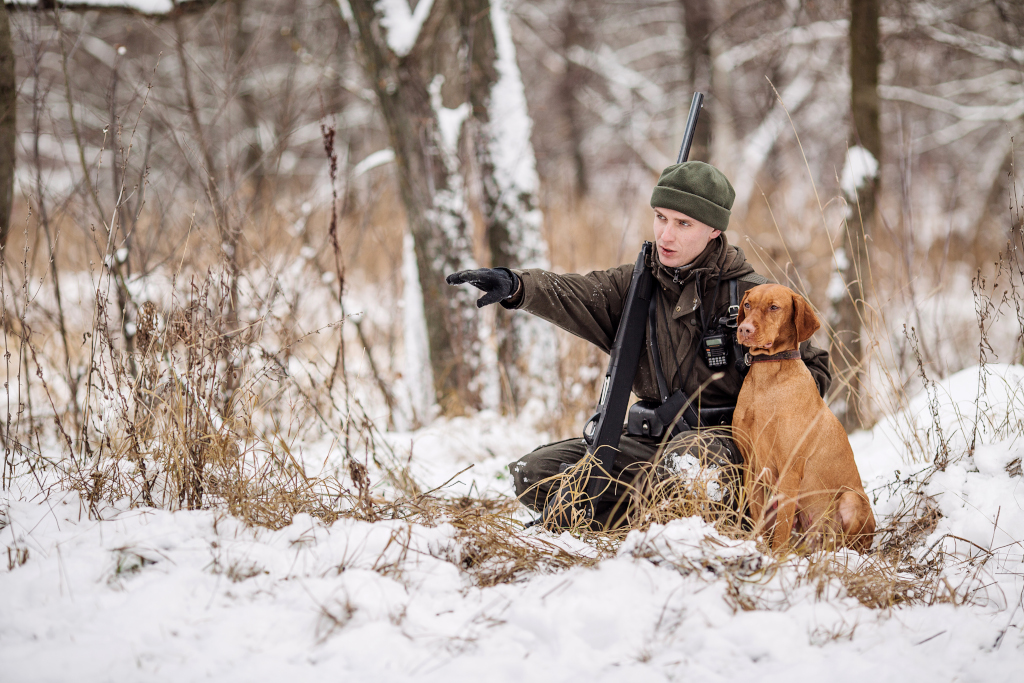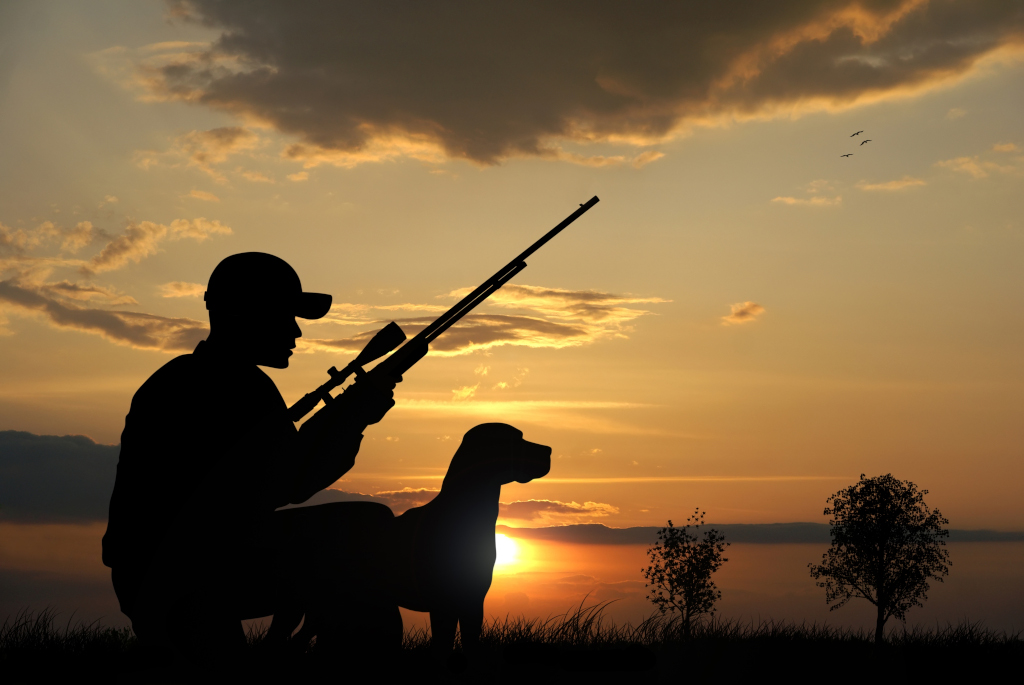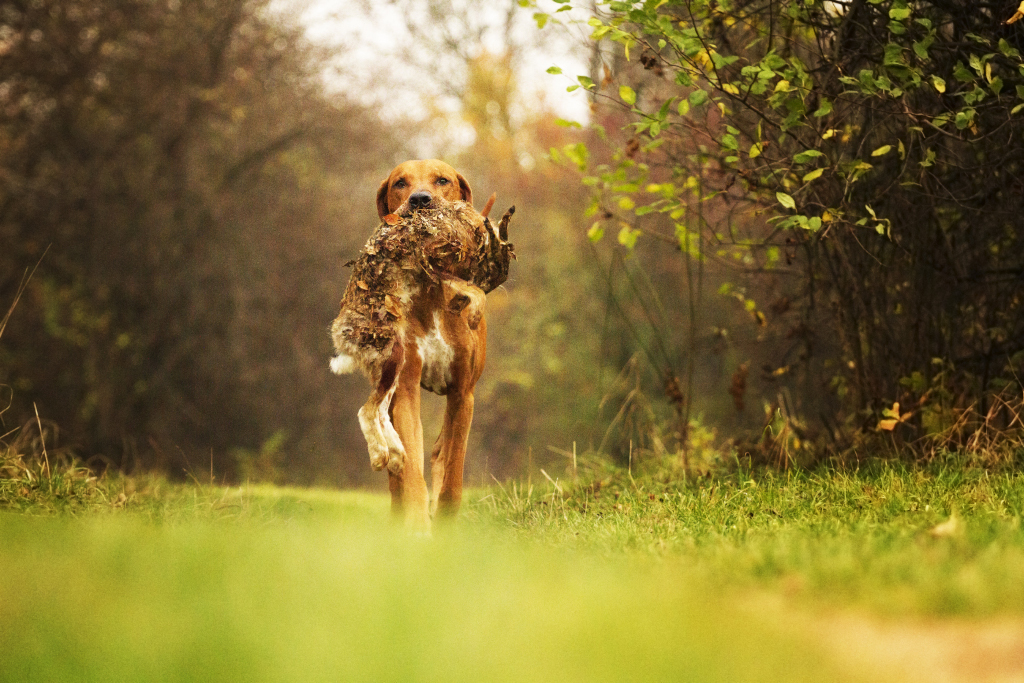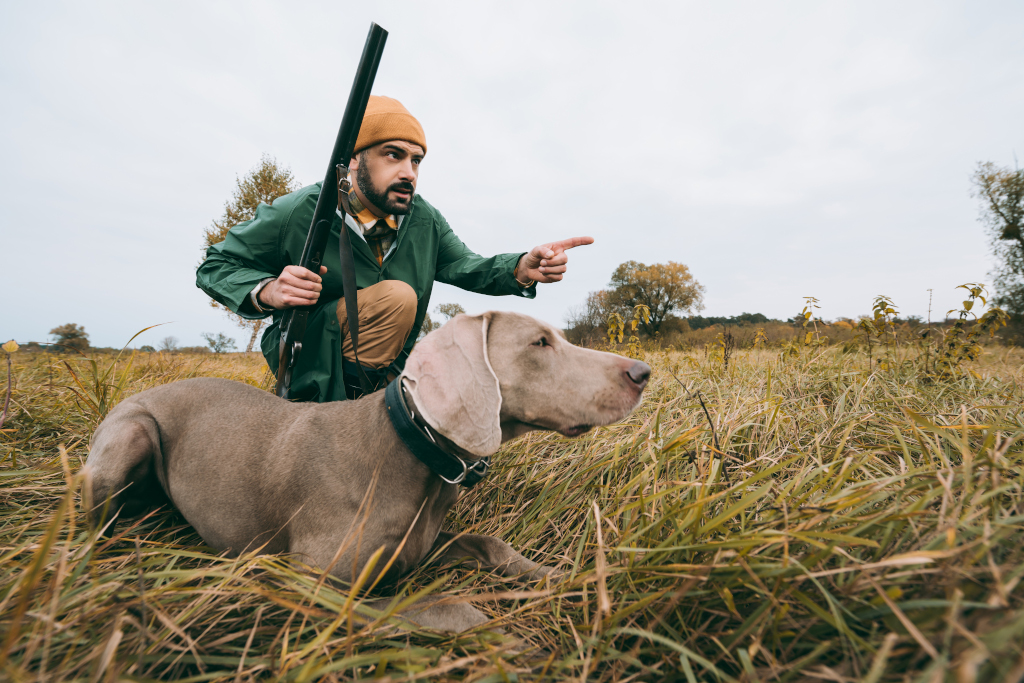
Hunters have used dogs for hunting since ancient times because they have some qualities that humans don’t, namely their keen sense of sight, smell, and hearing.
They can pick up scents from miles away or scents from a few days old, allowing them to sniff out prey or other animals and lead hunters right to their game.
And from hounds who can track down quarry to gun dogs who will retrieve downed birds, hunting dogs are invaluable during hunting trips. However, they need to be trained before the season starts. In fact, if you want to have a trustworthy furry hunting partner, you have to train them since they were puppies or as early as possible.
Here are my seven tips to help set your four-legged hunter up for success and turn them into a helpful and reliable hunting companion by your side during your next upland game bird or waterfowl hunting trips!
1. Start With Basic Obedience & Crate Training
Basic obedience is, without a doubt, a must for all hunting dogs! It is the key to having a well-mannered, obedient canine who responds to every verbal cue or hand signal. Basic obedience commands like “sit,” “stay,” “come,” “heel,” “here,” “place,” and “fetch” are standard commands that your gun dog should know.
A firm understanding of basic commands ensures that your pup is controllable and won’t wander off or chase after birds when you don’t want them to. And this isn’t just about teaching your dog to listen but also learning to work with you as their leader, which is essential when hunting.
Crate training is another vital part of building a solid foundation for your canine as it helps to housebreak them, teaches them to be independent when left alone, and of course, prevents destructive behavior like chewing on furniture or valuable belongings. But, more importantly, it provides them with a safe place to rest, relax, and retreat when they need time alone.
2. Socialize Your Gun Dog
Socialization also plays a critical role in gun dog training, and it is essential to get your pup accustomed to an ever-growing list of sights, sounds and smells that they will encounter throughout their lives.
This means constantly exposing your gun dog to new people, new dogs, new scents, different terrain, noises, weather, both dirty and clean water, your cars, ATVs, trucks, and whatnot. Not only will introducing them to different sights, sounds, and experiences at a young age help them learn and adjust to new surroundings more quickly, but it can also prevent shyness and fear from developing.
And the more you socialize your canine, the more confident they will become, which also means they will be able to deal with unfamiliar or unpredictable situations and respond appropriately. This ultimately helps them learn to trust and interact with others and prepares them to work seamlessly with you no matter the situation.
3. Introduce Your Bird Dog to Hunting Equipment & Gunfire

The next thing you need to do is, of course, introduce your gun dog to every piece of gear and equipment you will need and use during your hunts. This includes things like firearms, archery gear, decoys, blinds, bumpers, training wings, check chords, your dog’s vest, hunting dog GPS collars, etc.
Guns, in particular, are intimidating to dogs because of the loud noise. The last thing you want is your bird dog to become gun shy. While you can fix this, it’s going to take more time and patience than you would if you’ve handled this correctly from the get-go. So, make sure to take it slow and not rush the process.
The key is to gradually introduce your bird dog to gunfire while building up their confidence over time through positive reinforcement. You want your pup to associate gunfire with something good happening rather than something bad.
So how do you do it?
Well. You may have heard of the classic way of introducing hunting dogs to gunfire, and that is to fire a gun around them to see if they are gun shy. If you are lucky enough and that doesn’t startle your pup, then great. But the chances are, that shot will scare them, now what? You’ve created a gun-shy hunting dog yourself.
My advice here is, never fire a gun around your dog to test if they are gun shy. Instead, a better approach is to, first, desensitize your gun dog to loud noises by clapping your hands, clanging bowls, playing loud music, opening and closing doors, and making as much noise as you can. This way, when it’s about time to introduce them to the sound of gunfire, it won’t be such a shocker.
When they are ready, which is usually around five to eight months of age, depending on how confident your dog is, you can start with either one of those old air guns without pellets or a .22 caliber blank pistol, and you’ll need a friend’s help to do this correctly.
Have your friend stands 50 yards away, get your dog to sit, then signal your friend to get your dog’s attention, toss a bumper, fire the gun, and watch your dog’s reaction.
If your gun dog is afraid, don’t make a big deal of it and try again from a further distance where they won’t flinch or be fazed when they hear gunshots. But if they aren’t bothered whatsoever and went to retrieve the dummy, you can have your friend move 5 to 10 yards closer and repeat the process until you can fire the gun right next to your hunting dog.
Once your canine is 100% confident in every drill, you can start over again with a .410. Remember, the same rule applies. Always start at a distance and move the shooter in slowly. If your pup is frightened at any point, take a few steps back and reset.
This process can take weeks or even months. So don’t rush and take your time. Eventually, you would want to be able to move up to a 20-gauge, then a full 12-gauge shotgun.
4. Train Your Hunting Dog to Mark, Locate, & Retrieve Fallen Game

Marking a shot game is another fundamental part of bird dog training, and it’s one that all hunting dogs have to master. It is the ability to accurately memorize and pinpoint the exact location where a shot game fell.
To start with, I highly recommend conducting the training in a low-cut field so that your dog can clearly see and find the dummy. And once again, you’ll need a helper for this.
First, get your hunting dog into a sit position and have your friend stands about 30 yards away. And while your pup is sitting at your side, signal your friend to call your dog’s name to get their attention, toss a bumper out in a high arc so your bird dog can clearly see it, then send them out for the retrieve and have them bring the dummy back to you. You can also have your friend fire the gun instead of calling your dog’s name if your pup is already used to the loud sound of gunfire.
Start simple and easy, so your canine understands what is expected of them when marking a fallen bird or duck. Then, as your hunting dog becomes more confident, you can gradually increase the distance between you and your friend to teach your dog to focus and enhance its marking ability.
You would also need to train your pup in a different setting like woodlands and create more complex marks. For instance, have your friend throw the dummy from fields into cover and vice versa. Toss it from different angles and from ground level to higher elevations, shallow water levels, ponds, rivers, etc. Also, be sure to have your friend throw at a different spot. Like at the edge of the water, across a pond, ditches, or fences.
Some people like to toss bumpers themselves, but ideally, you want someone else to do that for you. The reason is that there’s a limit as to how far you can throw. If you constantly do it yourself, your dog will soon learn to only hunt at a certain distance and won’t mark any further.
Plus, in reality, when you’re out hunting, birds will appear ahead of you instead of coming from your side. With a friend’s help, your gun dog will learn to focus on what’s in front of them rather than your side, ultimately teaching them to mark better.
5. Train Your Bird Dog to Line Better

Dogs will run slightly off course, especially over long distances because of the wind, terrain, other distractions, and obstacles like trees, bushes, and ditches.
That also means there will be a lot of handling required from the handler to move the dog back on course. To avoid that, you’ll need to teach your canine to trust the line you give them so that they will run a clean, straight line regardless of what’s happening around them.
In fact, lining is one of the most crucial skills you need to teach your gun dog, and it’s the foundation for training blind retrieves. And the Lining Memories and Wagon Wheel Drill are perhaps the most popular lining drills and ones that most people will first do.
For the Lining Memories Drill, you want to place your pup in a sit position, toss the dummy out, turn 180 degrees around, get them to heel, and walk away in a straight line until you’re at a good distance. You can use a fence row to help your dog remember that it’s a straight line to discourage them from running wide. Then turn around, get your dog to heel, line them up, and send them out to retrieve.
As for the Wagon Wheel Drill, imagine you and your dog standing in the center of a wheel, and you want to throw out four bumpers in four different directions, usually at three, six, nine, and twelve o’clock. Then line your dog up with one of the bumpers and send them out to retrieve. When they’re back, re-heel them, line them up with another bumper you want them to retrieve, and send them out. Essentially, you’ll just need to repeat the same thing to retrieve every bumper you toss out.
6. Teach Your Hunting Dog the T-Pattern Drill
T-Pattern Drill is another foundation of training your dog for blind retrieves. We’ve talked about blind retrieves twice now. Why is that important? Well, because it essentially gives you better control over your hunting dog, teaches them to respond to your hand signals and whistles more quickly, ultimately allowing you to direct your dog to retrieve an unmarked downed bird.
To teach your canine the T-Pattern Drill, think of a baseball diamond with you and your pup at the home plate and bumpers at the first, second, and third base. Then, you want to send your bird dog to the back pile first, which is the second base. And ideally, you want to do this a few times before casting your dog to the first or third base. The reason is that if you don’t, your pup will anticipate they will get handled and slow down while they are at the pitcher’s mound.
7. Work on Steadiness
Many hunting dogs tend to bolt or take off after a bird is shot before the handler releases them or tells them to do so. You don’t want that because, first of all, it’s dangerous as your dog may accidentally get shot. Second of all, you want your canine to stay focused and mark the fall. And lastly, you don’t want them to flush other birds.
So how do you prevent that? Well, through steadiness drill, which teaches your gun dog to wait and be patient. And to do this, you want to put a lead on your dog, place them in a sit position, then toss the bumper out. If they move while you throw the dummy out, you’ll need to give it a few pops on the leash to correct them. Over time, they’ll learn that they are not allowed to move until you command them to do so.
The Bottom Line
Hunting season can be a joyous time of year, full of excitement and anticipation for what the next day will bring.
But if you don’t have a reliable hunting partner by your side who is sharp enough to pay attention to your commands and stay focused on the task at hand during your hunting trip, it can be very frustrating and discouraging.
Fortunately, you can train your pup to become a trustworthy hunting partner with the tips above.
Not only will you have a great hunting companion by your side but also a lifelong friend who will always be there for you. And remember that this doesn’t happen overnight. It takes lots of time and patience.
Recommended Reads:

